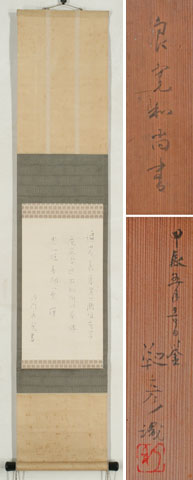Sôtô Zenga
Poem, Seibo, At the end of the yearSigned: Shamon Ryôkan sho
Seals:
Technique: sumi on paper 34,5 x 19,8
Mounting: green damask and beige silk 112,5 x 22,4
Box: authorised in 1940 by Kanô Chûshin (born 1864) and in 1964 by Yasuda Yukihiko (1884-1978)
Condition: top and bottom of the mounting stained, otherwise very good
遍界歳暮男女鬧 / 唯有草庵正安然 / 不知何以答佛恩 / 一爐香烟一坐禪
Sekku poem:
At the end of the year the world is full of the hurly-burly of men and women,
But in my grass hut reigns deep rest,
How shall I repay the Buddha for his favours?
– With incense from an incense burner and zazen. (HK)
http://www.rinku.zaq.ne.jp/syamon-syokaku/geju.html
Ryōkan Taigu was an eccentric Sōtō zen monk who for much of his life lived as a hermit. He is best known for his poetry and calligraphy, which present the essence of Zen life. He is still famous and his poetry is considered to be on a par with Bashô, Buson and Issa.
Ryōkan was born in the village of Izumozaki in Echigo Province (now Niigata Prefecture) in Japan to the village headman. at an early age to train at nearby Sōtō Zen temple Kōshō-ji, After a visit of the Zen master Kokusen (..-..) to ythe temple Ryôkan became his pupil and the two returned to Entsū-ji monastery in Tamashima (now Okayama Prefecture). After he received his enka Kikusen died a year late, after which Ryōkan left Entsū-ji to embark on a long pilgrimage. The rest of his monastic life he lived as a hermit and spent much of his time writing poetry, doing calligraphy, and communing with nature.
In 1826 Ryōkan became ill and was unable to continue living as a hermit. He moved into the house of one of his patrons, Kimura Motouemon, and was cared for by a young nun called Teishin.
Reference:
Next to a number of monographs
Addiss ‘06 p.239 ff
Price: ON REQUEST

